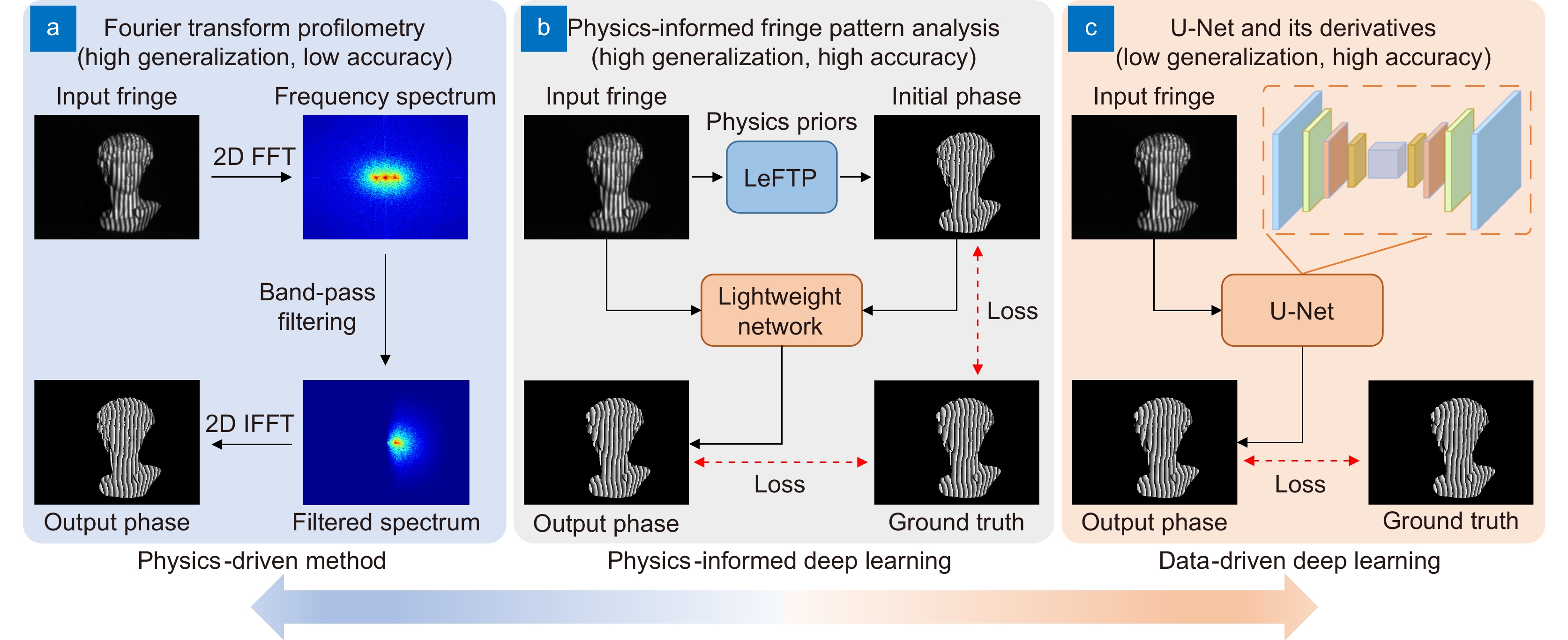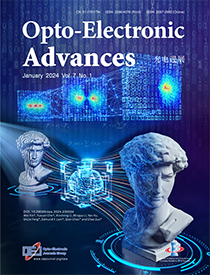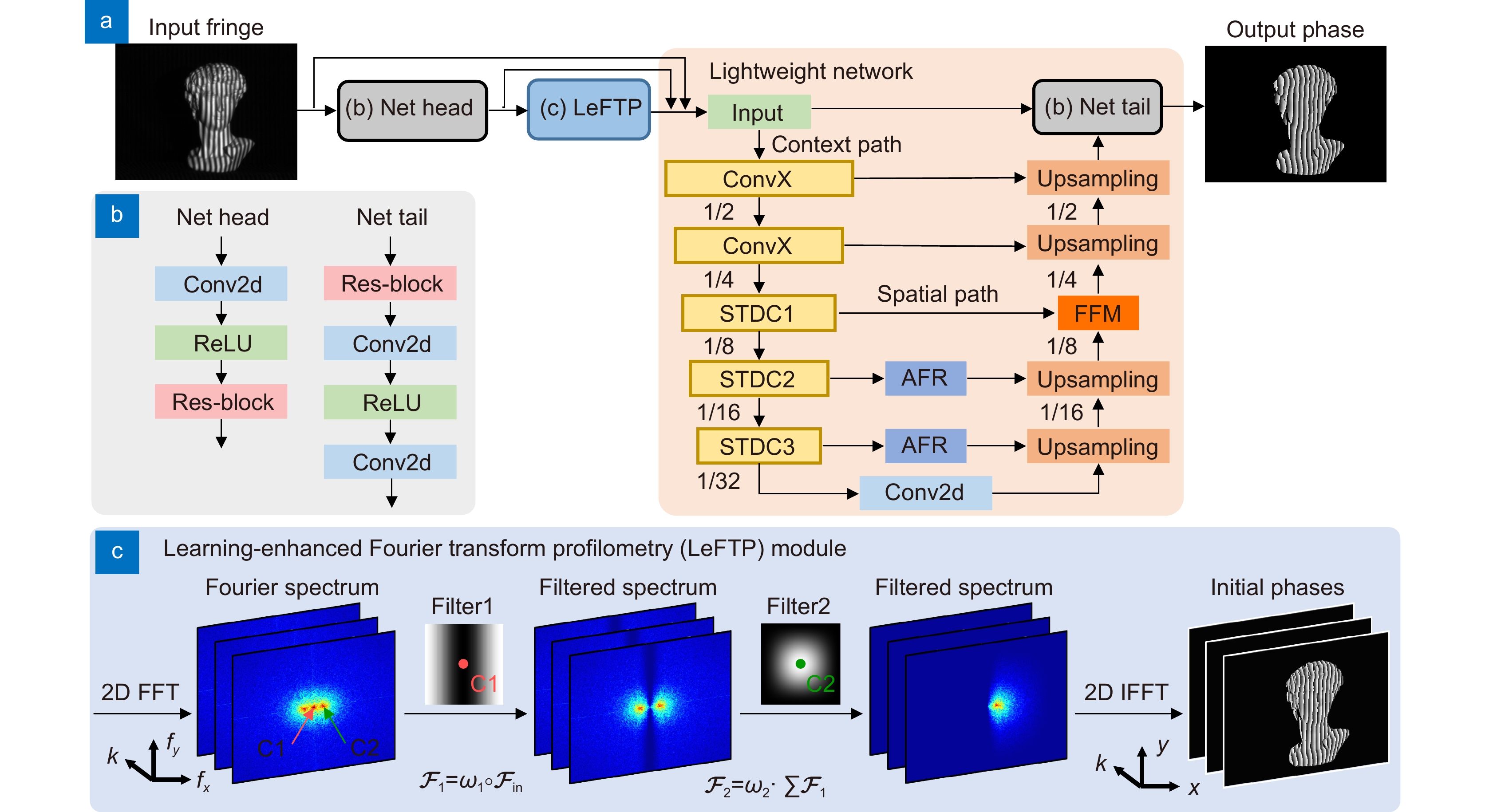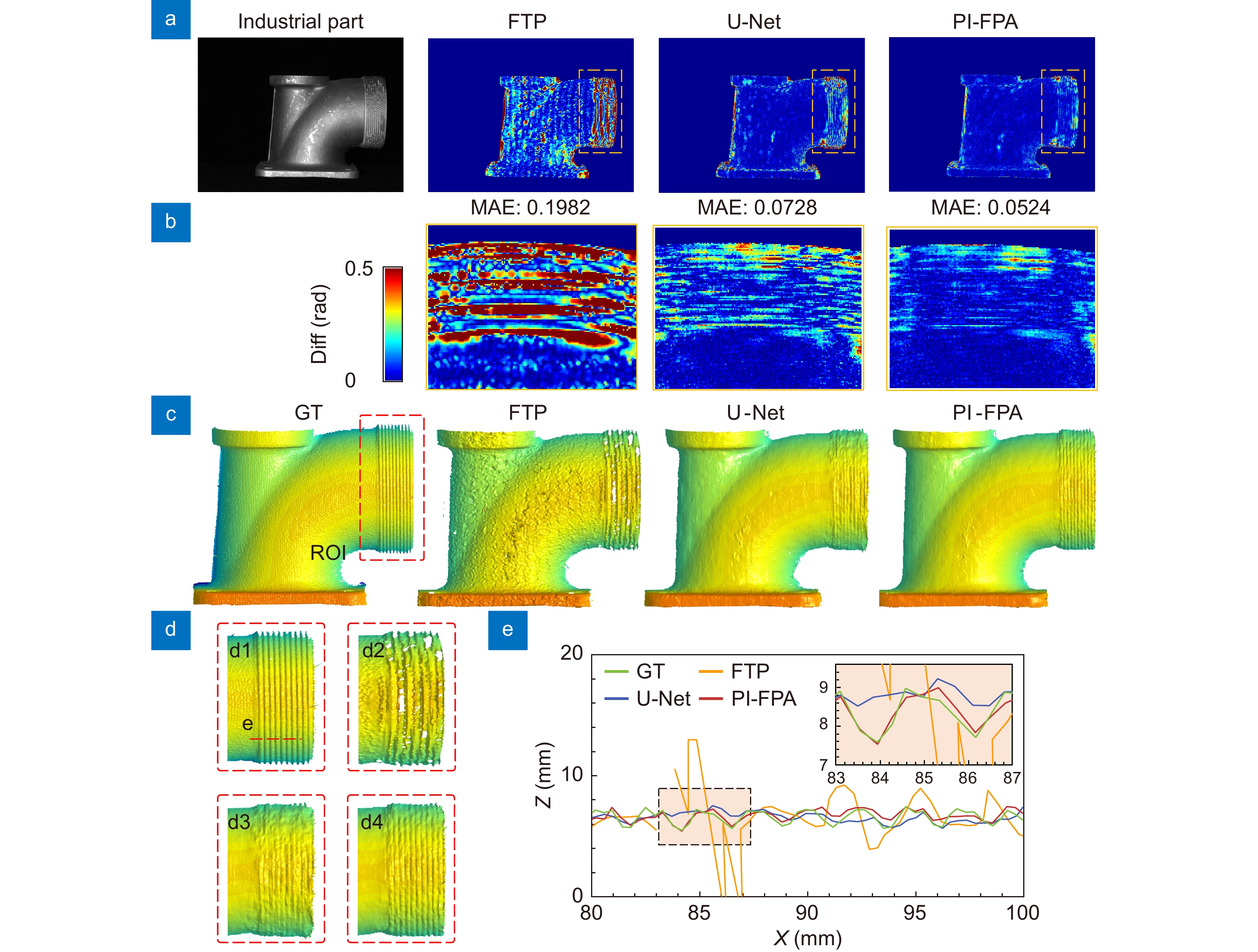| Citation: | Yin W, Che YX, Li XS et al. Physics-informed deep learning for fringe pattern analysis. Opto-Electron Adv 7, 230034 (2024). doi: 10.29026/oea.2024.230034 |
-
Abstract
Recently, deep learning has yielded transformative success across optics and photonics, especially in optical metrology. Deep neural networks (DNNs) with a fully convolutional architecture (e.g., U-Net and its derivatives) have been widely implemented in an end-to-end manner to accomplish various optical metrology tasks, such as fringe denoising, phase unwrapping, and fringe analysis. However, the task of training a DNN to accurately identify an image-to-image transform from massive input and output data pairs seems at best naïve, as the physical laws governing the image formation or other domain expertise pertaining to the measurement have not yet been fully exploited in current deep learning practice. To this end, we introduce a physics-informed deep learning method for fringe pattern analysis (PI-FPA) to overcome this limit by integrating a lightweight DNN with a learning-enhanced Fourier transform profilometry (LeFTP) module. By parameterizing conventional phase retrieval methods, the LeFTP module embeds the prior knowledge in the network structure and the loss function to directly provide reliable phase results for new types of samples, while circumventing the requirement of collecting a large amount of high-quality data in supervised learning methods. Guided by the initial phase from LeFTP, the phase recovery ability of the lightweight DNN is enhanced to further improve the phase accuracy at a low computational cost compared with existing end-to-end networks. Experimental results demonstrate that PI-FPA enables more accurate and computationally efficient single-shot phase retrieval, exhibiting its excellent generalization to various unseen objects during training. The proposed PI-FPA presents that challenging issues in optical metrology can be potentially overcome through the synergy of physics-priors-based traditional tools and data-driven learning approaches, opening new avenues to achieve fast and accurate single-shot 3D imaging. -

-
References
[1] Gåsvik KJ. Optical Metrology 3rd ed (John Wiley & Sons, West Sussex, 2002). [2] Wyant JC, Creath K. Recent advances in interferometric optical testing. Laser Focus 21, 118–132 (1985). doi: 10.3103/S875669902004007X [3] Kulkarni R, Rastogi P. Optical measurement techniques-A push for digitization. Opt Lasers Eng 87, 1–17 (2016). doi: 10.1016/j.optlaseng.2016.05.002 [4] Hariharan P. Basics of Interferometry 2nd ed (Elsevier, Amsterdam, 2010). [5] Schnars U, Falldorf C, Watson J et al. Digital Holography and Wavefront Sensing 2nd ed (Springer, Berlin Heidelberg, 2015). [6] Gorthi SS, Rastogi P. Fringe projection techniques: whither we are? Opt Lasers Eng 48, 133–140 (2010). doi: 10.1016/j.optlaseng.2009.09.001 [7] Geng J. Structured-light 3D surface imaging: a tutorial. Adv Opt Photon 3, 128–160 (2011). doi: 10.1364/AOP.3.000128 [8] Servin M, Quiroga JA, Padilla JM. Fringe Pattern Analysis for Optical Metrology: Theory, Algorithms, and Applications (John Wiley & Sons, Weinheim, 2014). [9] Su XY, Chen WJ. Fourier transform profilometry: a review. Opt Lasers Eng 35, 263–284 (2001). doi: 10.1016/S0143-8166(01)00023-9 [10] Kemao Q. Windowed fourier transform for fringe pattern analysis. Appl Opt 43, 2695–2702 (2004). doi: 10.1364/AO.43.002695 [11] Zuo C, Feng SJ, Hiang L et al. Phase shifting algorithms for fringe projection profilometry: a review. Opt Lasers Eng 109, 23–59 (2018). doi: 10.1016/j.optlaseng.2018.04.019 [12] Barbastathis G, Ozcan A, Situ G. On the use of deep learning for computational imaging. Optica 6, 921–943 (2019). doi: 10.1364/OPTICA.6.000921 [13] Zuo C, Qian JM, Feng SJ et al. Deep learning in optical metrology: a review. Light Sci Appl 11, 39 (2022). doi: 10.1038/s41377-022-00714-x [14] Yan KT, Yi YJ, Huang CT et al. Fringe pattern denoising based on deep learning. Opt Commun 437, 148–152 (2019). doi: 10.1016/j.optcom.2018.12.058 [15] Kulkarni R, Rastogi P. Fringe denoising algorithms: a review. Opt Lasers Eng 135, 106190 (2020). doi: 10.1016/j.optlaseng.2020.106190 [16] Feng SJ, Chen Q, Gu GH et al. Fringe pattern analysis using deep learning. Adv Photon 1, 025001 (2019). doi: 10.1117/1.AP.1.2.025001 [17] Ren ZB, Xu ZM, Lam EYM. End-to-end deep learning framework for digital holographic reconstruction. Adv Photon 1, 016004 (2019). doi: 10.1117/1.AP.1.1.016004 [18] Rivenson Y, Zhang YB, Günaydın H et al. Phase recovery and holographic image reconstruction using deep learning in neural networks. Light Sci Appl 7, 17141 (2018). [19] Liu KX, Wu JC, He ZH et al. 4K-DMDNet: diffraction model-driven network for 4K computer-generated holography. Opto-Electron Adv 6, 220135 (2023). doi: 10.29026/oea.2023.220135 [20] Feng SJ, Zuo C, Yin W et al. Micro deep learning profilometry for high-speed 3D surface imaging. Opt Lasers Eng 121, 416–427 (2019). doi: 10.1016/j.optlaseng.2019.04.020 [21] Qiao G, Huang YY, Song YP et al. A single-shot phase retrieval method for phase measuring deflectometry based on deep learning. Opt Commun 476, 126303 (2020). doi: 10.1016/j.optcom.2020.126303 [22] Li YX, Qian JM, Feng SJ et al. Deep-learning-enabled dual-frequency composite fringe projection profilometry for single-shot absolute 3D shape measurement. Opto-Electron Adv 5, 210021 (2022). doi: 10.29026/oea.2022.210021 [23] Yang T, Zhang ZZ, Li HH et al. Single-shot phase extraction for fringe projection profilometry using deep convolutional generative adversarial network. Meas Sci Technol 32, 015007 (2020). doi: 10.1088/1361-6501/aba5c5 [24] Yin W, Zhong JX, Feng SJ et al. Composite deep learning framework for absolute 3D shape measurement based on single fringe phase retrieval and speckle correlation. J Phys Photon 2, 045009 (2020). doi: 10.1088/2515-7647/abbcd9 [25] Feng SJ, Xiao YL, Yin W et al. Fringe-pattern analysis with ensemble deep learning. Adv Photon Nexus 2, 036010 (2023). doi: 10.1117/1.APN.2.3.036010 [26] Osten W. What optical metrology can do for experimental me chanics. Appl Mech Mater 70, 1–20 (2011). doi: 10.4028/www.scientific.net/AMM.70.1 [27] Goy A, Arthur K, Li S et al. Low photon count phase retrieval using deep learning. Phys Rev Lett 121, 243902 (2018). doi: 10.1103/PhysRevLett.121.243902 [28] Wang F, Bian YM, Wang HC et al. Phase imaging with an untrained neural network. Light Sci Appl 9, 77 (2020). doi: 10.1038/s41377-020-0302-3 [29] Saba A, Gigli C, Ayoub AB et al. Physics-informed neural networks for diffraction tomography. Adv Photon 4, 066001 (2022). [30] Reid GT. Automatic fringe pattern analysis: a review. Opt Lasers Eng 7, 37–68 (1986–1987). [31] Rajshekhar G, Rastogi P. Fringe analysis: premise and perspectives. Opt Lasers Eng 50, iii–x (2012). doi: 10.1016/j.optlaseng.2012.04.006 [32] Weise T, Leibe B, Van Gool L. Fast 3D scanning with automatic motion compensation. In Proceedings of 2017 IEEE Conference on Computer Vision and Pattern Recognition 1–8 (IEEE, 2007); http://doi.org/10.1109/CVPR.2007.383291. [33] Feng SJ, Zuo C, Tao TY et al. Robust dynamic 3-D measurements with motion-compensated phase-shifting profilometry. Opt Lasers Eng 103, 127–138 (2018). doi: 10.1016/j.optlaseng.2017.12.001 [34] Zuo C, Tao TY, Feng SJ et al. Micro Fourier Transform Profilometry (μFTP): 3D shape measurement at 10, 000 frames per second. Opt Lasers Eng 102, 70–91 (2018). doi: 10.1016/j.optlaseng.2017.10.013 [35] Yu CQ, Wang JB, Peng C et al. BiSeNet: bilateral segmentation network for real-time semantic segmentation. In Proceedings of the 15th European Conference on Computer Vision 325–341 (Springer, 2018); http://doi.org/10.1007/978-3-030-01261-8_20. [36] Fan MY, Lai SQ, Huang JS et al. Rethinking BiSeNet for real-time semantic segmentation. In Proceedings of 2021 IEEE/CVF Conference on Computer Vision and Pattern Recognition 9716–9725 (IEEE, 2021); http://doi.org/10.1109/CVPR46437.2021.00959. [37] Tao TY, Chen Q, Feng SJ et al. High-precision real-time 3D shape measurement based on a quad-camera system. J Opt 20, 014009 (2018). doi: 10.1088/2040-8986/aa9e0f [38] Feng SJ, Chen Q, Zuo C. Graphics processing unit-assisted real-time three-dimensional measurement using speckle-embedded fringe. Appl Opt 54, 6865–6873 (2015). doi: 10.1364/AO.54.006865 [39] Liu K, Wang YC, Lau DL et al. Dual-frequency pattern scheme for high-speed 3-D shape measurement. Opt Express 18, 5229–5244 (2010). doi: 10.1364/OE.18.005229 -
Supplementary Information
Supplementary information for Physics-informed deep learning for fringe pattern analysis 
supplymentary movie 
-
Access History

Article Metrics
-
Figure 1.
Diagrams of the physics-driven method, physics-informed deep learning approach, and data-driven deep learning approach for fringe pattern analysis.
-
Figure 2.
Overview of the proposed PI-FPA. (a) PI-FPA including a LeFTP module and a lightweight network. (b) Net head and Net tail. (c) The phase retrieval process of the LeFTP module.
-
Figure 3.
Comparative results for single-shot fringe pattern analysis of the David model. (a–e) The phase retrieval process, wrapped phases, phase errors, and magnified views of the phase errors using FTP, LeFTP, Net head + LeFTP, U-Net, and PI-FPA.
-
Figure 4.
Comparative fringe analysis results of the industrial part. (a) The industrial part and the phase errors using FTP, U-Net, and PI-FPA. (b) The magnified views of the phase errors. (c) Single-shot 3D imaging results using different methods. (d) The magnified views of (c). (e) The line profiles in (d).
-
Figure 5.
Precision analysis for a ceramic plane and a standard sphere moving along the Z axis. (a) 3D reconstruction results using PI-FPA at different time points. (b–c) the error distributions of the sphere and plane. (d–e) temporal precision analysis results of the plane and sphere over a 1.62 s period using 3-step PS, FTP, U-Net, and PI-FPA. (f–i) the color-coded 3D reconstruction and the corresponding error distributions of the plane and the standard sphere using different methods at T = 0.81 s.
-
Figure 6.
Fast 3D measurement results using different fringe pattern analysis methods. (a) The representative fringe images at different time points and the corresponding color-coded 3D reconstructions results for the rotated workpiece model using 3-step PS, FTP, U-Net, and PI-FPA. (b) The representative fringe images at different time points and the corresponding color-coded 3D reconstructions results for non-rigid dynamic face using 3-step PS, FTP, U-Net, and PI-FPA. (c) 360-degree 3D reconstruction of the workpiece model using PI-FPA. (d) 3D measurement results of non-rigid dynamic face using PI-FPA.

 E-mail Alert
E-mail Alert RSS
RSS



 DownLoad:
DownLoad:







